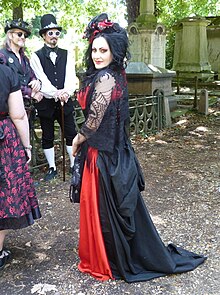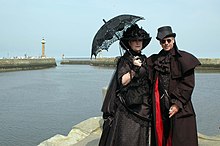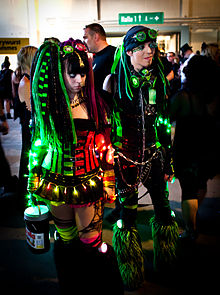What Is the Origin of the Goth Fashion Style?


Gothic fashion is a clothing mode marked by nighttime, mysterious, antiquated, homogenous, and often genderless features. Information technology is worn by members of the Goth subculture. Clothes,[ane] typical gothic fashion includes dyed blackness pilus, exotic hairstyles, dark lipstick and dark clothing.[1] Both male and female goths tin can vesture dark eyeliner, dark boom polish and lipstick - most often black, dramatic makeup[two] and sometimes fishnets. Male goths use cosmetics at a higher rate than other men. Styles are often borrowed from the punk manner (such equally spiked wristbands and chokers.) Victorians and Elizabethans.[1] Goth way is sometimes confused with heavy metallic fashion and emo fashion.
Characteristics [edit]

A male person and female person Goth couple
Cintra Wilson declares that "The origins of gimmicky goth style are found in the Victorian cult of mourning."[3] Valerie Steele is an expert in the history of the mode.[three]

Goth subculture is stereotyped as eerie, mysterious, and complex, and the way is used as an outlet to express these characteristics. Goth mode can be recognized by its stark black clothing. Ted Polhemus described goth style as a "profusion of black velvets, lace, fishnets and leather tinged with cherry-red or purple, accessorized with tightly laced corsets, gloves, precarious stilettos and silverish jewelry depicting religious or occult themes".[4]
Nancy Kilpatrick'south Goth Bible: A Compendium for the Darkly Inclined defines "poseur" for the goth scene as follows: "goth wannabes, usually young kids going through a goth phase who do not concur to goth sensibilities only desire to exist function of the goth crowd (...)". Kilpatrick contributor "Daoine O'" denigrates poseur goths as 'Batbabies' whose clothing is bought at [mall shop] Hot Topic with their parents' money".[5]
Icons [edit]
One female role model is Theda Bara, the 1910s femme fatale known for her dark eyeshadow.[6] [7] Siouxsie Sioux was particularly influential on the dress way of the Gothic rock scene; Paul Morley of NME described Siouxsie and the Banshees' 1980 gig at Futurama: "[Siouxsie was] modeling her newest outfit, the ane that will influence how all the girls clothes over the next few months. About half the girls at Leeds had used Sioux as a basis for their appearance, pilus to ankle."[8] Robert Smith,[nine] Musidora, Bela Lugosi,[10] Bettie Folio, Vampira, Morticia Addams,[7] Nico, Rozz Williams, David Bowie,[ane] Lux Interior,[1] Dave Vanian,[xi] are also style icons. The 1980s established designers such as Drew Bernstein of Lip Service, while the 1990s saw a surge of US-based gothic fashion designers, many of whom proceed to evolve the style through the current 24-hour interval. Style magazines such every bit Gothic Beauty accept given repeat features to a select few gothic mode designers who began their labels in the 1990s, such every bit Kambriel, Rose Mortem, and Tyler Ondine of Heavy Cerise.[12] Influential goth models include Wednesday Mourning and Lady Amaranth.
Music [edit]
During the emergence of the goth subculture in 1980's London,[xiii] many genres of music played a large role in establishing the manner trends - fashion spelled out the music an private would listen to. Because of its origins, the major music inspirations during the early emergence of the goth subculture were similarly English bands. Some bands who have influence gothic fashion over the years include bands similar Bauhaus, The Cure, Sisters of Mercy, and Siousxie and the Banshees [14]
The Batcave Club was a nightclub in London, between 1982-1986, that hosted live music and paid homage to all things goth. The interior, as described by Kelly Rankin, included cob-webbed ceilings and a real coffin at the archway. She says that "The Batcave became iconic because information technology aided the progression of this move".[13]
Post-Punk [edit]
Goth subculture that emerged from the post-punk music scene was characterized by a honey for the occult and a certain dark fashion aesthetic wearing black clothing.[ii]
Rock/Gothic Rock [edit]
Metallic [edit]
Variations [edit]
Deathrock [edit]
Deathrock fashion, much like Goth music, is closely related to Goth fashion. The influences of the mode come from a blend of glam rock, punk rock, gothic horror literature, and undead characters of classic horror films. The aesthetic was born from the early Los Angeles punk stone scene, and gained influences from fashion worn past patrons of the Batcave club in the UK every bit the two regional scenes had met. Many Deathrockers have a dark DIY punk approach on their attire. The common theme of the aesthetic is dominantly black clothing: shirts featuring Deathrock bands or horror themes, torn fishnets equally a shirt and/or hosiery, stake fleshtone or stake white foundation and powder makeup on the face, blackness or darkly colored middle makeup, gainsay boots or Doc Martens, and skirts, leggings, slim fit pants or shorts. Iconic hairstyles of this style are the "Deathhawk", mohawks or variants of mohawks, and spiky or teased hair. The horror punk and deathrock way department of the punk manner commodity has more details.
Haute Goth [edit]
In 1977, Karl Lagerfeld hosted the Soirée Moratoire Noir party, specifying "tenue tragique noire absolument obligatoire" (black tragic clothes absolutely required).[15] The event included elements associated with leatherman style.[15]
Goth fashion has a reciprocal relationship with the way world. In the later part of the offset decade of the 21st century, designers such every bit Alexander McQueen,[3] [xvi] [17] Anna Sui,[18] Rick Owens,[17] Gareth Pugh, Ann Demeulemeester, Philipp Plein, Hedi Slimane, John Richmond, John Galliano,[3] [16] [17] Olivier Theyskens[17] [nineteen] and Yohji Yamamoto[17] brought elements of goth to runways.[iii] This was described equally "Haute Goth" by Cintra Wilson in the New York Times.[3] Thierry Mugler, Claude Montana, Jean Paul Gaultier and Christian Lacroix have besides been associated with a gothic style.[16] In Leap 2004, Riccardo Tisci, Jean Paul Gaultier, Raf Simons and Stefano Pilati dressed their models as "glamorous ghouls dressed in form-plumbing equipment suits and coal-tinted cocktail dresses".[xix] Swedish designer Helena Hörstedt and jewelry artist Hanna Hedman likewise practise a goth aesthetic.[20]
Gothic Lolita [edit]
Gothic Lolita, sometimes shortened to gosu rori ( ゴスロリ ) in Japanese, is a combination of Gothic and Lolita fashions. The fashion originated in the tardily 1990s in Harajuku.[21]
Gothic Lolita fashion is characterized by darker brand-up and habiliment.[22] Carmine lipstick and smokey or neatly defined eyes, created using blackness eyeliner, are typical styles, although as with all lolita sub-styles the look remains fairly natural.[23] Though Gothic make-up has been associated with a white-powdered face, this is usually considered poor taste within the (largely Japanese) lolita fashion scene.[24]
Brands which exemplify the Gothic Lolita way include Atelier-Pierrot, Atelier Boz, Blackness Peace Now, H. Naoto Blood and Moi-même-Moitié. Author and Tv Host La Carmina is a popular model of Gothic Lolita fashion.
Aristocrat [edit]
Blueblood is a type of Japanese street fashion, championed past the visual kei stone musician Mana with his fashion label Moi-même-Moitié,[25] and influenced by gothic and Neo-Victorian fashions. A typical outfit will combine elements of fetish wear with Victorian and sometimes steampunk fashions, including tight pants, velvet sportcoats, top hats, cravats, corsets, talocrural joint length skirts, lace petticoats, and the frilly pirate shirts previously popularised past the New Romantics of the 1980s.

Victorian Goth inspired fashion
Cybergoth [edit]

The Cybergoth and rivethead subcultures emerged in America during the tardily 1990s, and combined classic gothic fashions such every bit leather duster coats, tripp pants or Demonia brand platform boots with the article of clothing worn by fans of industrial metallic and rave music to create a dystopian, futuristic science fiction expect.[26] [27] Shaved heads, synthetic neon dreadlocks, camouflage, tight leather pants, chains, platform boots,[28] stretched body piercings, sleeve tattoos, goggles, corsets, PVC or leather skirts, and blackness trenchcoats busy with metallic studs are frequently seen on members of this subculture.[29]
Traditional Goth [edit]
Traditional Goth (or Trad Goth) is a term defining the aesthetic that reflects the classic and original aesthetics of Goth from the 1980s. The examples are from the attire worn by Bauhaus (band), Siouxsie Sioux, and The Cure. Dominantly black clothing, creepers, winklepickers, and backcombed, disheveled hair are common. Patrons of the Batcave club in the Britain had an impact on the way with the attire they wore. This too has shut relation to the Deathrock revival and manner, every bit the 1980s Goth and Batcavers fashion influenced the aesthetic over the decades into the 2010s.
Victorian Goth [edit]
Victorian Goth (also referred to as Neo-Victorian) is a modern fashion movement that interprets and redefines certain aspects regarding fashion of the Victorian Era.[30] The Victorian Era is notable for having big dresses and elegant pilus, and these elements have made subsequent integration into modern 24-hour interval main stream gothic fashion. With early inspiration taken from medieval settings that were used past Edgar Allen Poe, in add-on to belatedly-Victorian examples of gothic way that are used in Bram Stoker's Dracula. [31]
[edit]
Social media has increased the level of sensation surrounding gothic fashion trends, but this has also modified the dynamic and expectations within the community itself.[14] Bianca Wooden describes the emergence of a new moving ridge of goth fad fashion and says that "goth has become less of an organic move and more of a calculated brand".[14]
Performative Gothic Style [edit]
Goth YouTuber Angela Benedict describes in this video, some of the negative impacts that social media has had on gothic fashion. Some of these include the increased emergence of "elitist goths"[xiv] who shame others for not being "goth" enough. This has led to many online goths who portray their gloomy attire and dramatic makeup looks only to take pictures or moving-picture show videos.[fourteen]
Come across too
- Body image
- Heavy metal fashion
- Fetish fashion
- New Gothic Art
- Punk fashion
- Gothic Subculture
- Occult
Fashion accessories
- Choker
- Fishnet
- High-heeled shoes
- Pointed boots
- Thigh-high boots
References [edit]
- Footnotes
- ^ a b c d eastward Grunenberg 1997, p. 172
- ^ a b Fischer, Rachel K. (22 June 2019). "The Alert Collector: The Gothic Aesthetic: From the Ancient Germanic Tribes to the Contemporary Goth Subculture". Reference & User Services Quarterly. 58 (iii): 143–148. ISSN 1094-9054.
- ^ a b c d e f Cintra Wilson, "You only can't kill it", New York Times, 17 September 2008. [i] Access date: xviii September 2008.
- ^ Polhemus 1994, p. 97
- ^ Nancy Kilpatrick. Goth Bible: A Compendium for the Darkly Inclined. St. Martin's Griffin, 2004, p. 24
- ^ Hannaham 1997, p. 93
- ^ a b Steele & Park 2008, p. 26
- ^ Reynolds, p. 425.
- ^ Hannaham 1997, p. 113
- ^ Steele & Park 2008, p. eighteen
- ^ Steele & Park 2008, p. 38
- ^ Holiday, Steven (12 December 2014). "Gothic Beauty". Portland, OR: Holiday Media. Retrieved 12 December 2014.
- ^ a b "The Batcave Club, London: Where the 1980s goth movement began". vii October 2020. Retrieved 12 December 2021.
- ^ a b c d east biancawooden (xiii November 2016). "Goths On Social Media Are Changing the Subculture". Millennial Influx . Retrieved 12 Dec 2021.
- ^ a b Steele & Park 2008, p. 35
- ^ a b c Grunenberg 1997, p. 173
- ^ a b c d e Steele & Park 2008, p. 3
- ^ Bolton, Andrew (2013). Anna Sui. New York: Chronicle Books. pp. 100–109. ISBN978-1452128597 – via Google Books.
- ^ a b La Ferla, Ruth: "Embrace the Darkness". New York Times, 30 Oct 2005. [2]
- ^ Johanna Lenander, "Swede and Sour: Scandinavian Goth," New York Times: T Mag, 27 March 2009. [3] Admission date: 29 March 2009.
- ^ [4] Archived 21 March 2012 at the Wayback Motorcar
- ^ Aoki, Deb. "Interview with the Editors of the Gothic and Lolita Bible". About.com. Retrieved 10 May 2010.
- ^ Anonymous (2002). "Gothic Lolita Hair and Make Up". Gothic & Lolita Bible. Nuuberuguu. 4: 79.
- ^ Anonymous (2002). "Neo Gothic Style". Gothic & Lolita Bible. Nuuberuguu. 4: 81.
- ^ Anonymous (2002). "Artist Brands: Office 1, Mana 10 Moi-mene-Moitie". Gothic & Lolita Bible. Nuuberguu. 4: 23.
- ^ Dead stylish. Theage.com.au (13 September 2002).
- ^ [Lauren M. E. Goodlad, Michael Bibby: Goth. Undead subculture, Duke University Press, 2007, ISBN 978-0-8223-3921-ii, p. 47]
- ^ "Gothic Fashion & article of clothing : The different variations of this style". Sew Guide . Retrieved ii January 2020.
- ^ [Baddeley, Gavin (2002). Goth Chichi: A Connoisseur'southward Guide to Dark Culture. London: Plexus Publishing, p. 204.]
- ^ Liz, ~ (18 June 2012). "From Conventions to Curators: Historical Gothic Victorian Style". The Businesslike Costumer . Retrieved 12 December 2021.
{{cite web}}: CS1 maint: numeric names: authors list (link) - ^ "British Library". www.bl.great britain . Retrieved 12 December 2021.
- Bibliography
- Grunenberg, Christoph (1997). "Unsolved Mysteries: Gothic Tales from Frankenstein to the Hair Eating Doll". Gothic: Transmutations of Horror in Late-Twentieth-Century Art. Boston: Mit Press. ISBN978-0-262-57128-9 . Retrieved 21 Dec 2011.
- Hannaham, James (1997). "Bela Lugosi's Dead and I Don't Feel So Good Either: Goth and the Glorification of Suffering in Rock Music". Gothic: Transmutations of Horror in Belatedly-Twentieth-Century Art. Boston: Mit Press. ISBN978-0-262-57128-nine . Retrieved 21 December 2011.
- Polhemus, Ted (1994). Streetstyle: from sidewalk to catwalk . Thames and Hudson. ISBN978-0-500-27794-ii . Retrieved 21 December 2011.
- Steele, Valerie; Park, Jennifer (21 October 2008). Gothic: Night Glamour. Yale University Press and the Manner Institute of Applied science. ISBN9780300136944 . Retrieved 21 Dec 2011.
External links [edit]
![]() Media related to Gothic fashion at Wikimedia Commons
Media related to Gothic fashion at Wikimedia Commons
0 Response to "What Is the Origin of the Goth Fashion Style?"
Post a Comment